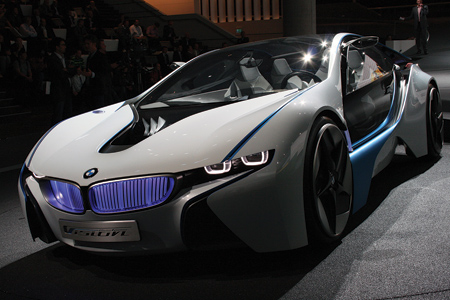
Schröter Modell- und Formenbau produces molds for the automotive industry. For racing, the company manufactures models, molds and tools for the complete carbon fiber body and for all engine and interior components.
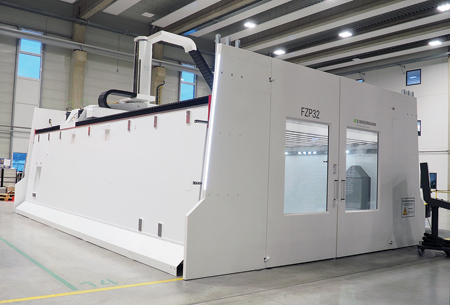
The 5-axis FZP32 portal milling machine is accurate due to its thermosymmetrical design. It offers high productivity and untended operation for the shop.
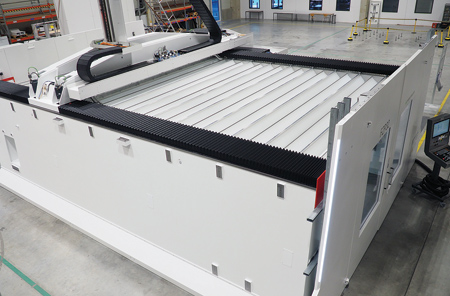
Schröter is able to process complete vehicle models from five sides in a single set-up.
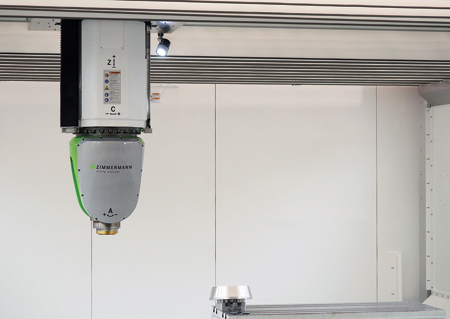
"In addition to high power density, the focus during the development of the VH10 milling head was on its slim line," said Frieder Gänzle of Zimmermann.
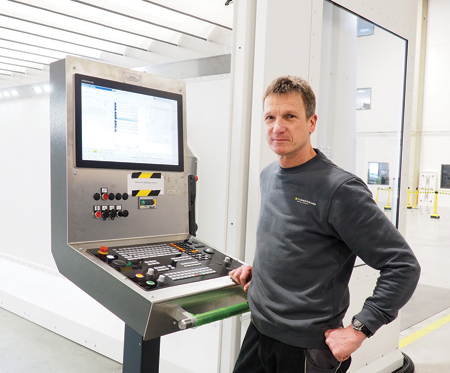
The new system is equipped with Tebis simulation software and HEIDENHAIN CNC.
How do processing companies react correctly in times of crisis? "Many think short-term, by reducing their costs and staff. When the industry booms again, they are not prepared for a rush in incoming orders and usually need to reject projects because there is simply no capacity," said Maximilian Lörzel, Managing Director of Schröter Modell- und Formenbau GmbH in Oberpframmern, Germany. "In November 2021, we were faced with this question: How do we react to the corona pandemic, which worsened the order situation and forced us to reduce hours? No one could assess the situation, but we knew at some point the crisis would be over. We wanted to be prepared for that." Uncharacteristically for this time, he decided to invest in a new portal milling machine, the Series FZP32 from Zimmermann, with a working range of 7,000 mm x 3,500 mm x 2,500 m. "It was certainly a risk, but also a clear signal for the future, to our customers and our employees," he said.
In 1963, Lörzel's uncle Bruno Schröter built up the company in Munich. In the beginning of the 1990s, he took over the business, which has been growing steadily ever since. Today, the company manufactures parts or molds for prototypes, but not production runs. In addition, there are foundry and design models, sheet metal forming tools made of aluminum or plastic as well as the processing of softer materials such as foam, clay and ureol. Schröter also processes carbon fiber and steel. "About 50% of our customers are from the automotive industry," said Lörzel. "Among them are names like BMW, Audi, Volkswagen, Mercedes and Porsche." By 2022, the company milled almost 70 one-to-one models.
However, Lörzel said his company does not want to be dependent on one industry. Diversification is important, which is why almost 40% of orders now come from the aerospace industry. Another new growing field is medical technology, where he and his 40 employees take on the production of complex prototypes for computer tomographs (CT) or surgical robots.
Stable, Fast, Flexible Machines
"What makes us so successful is that we have highly qualified employees who are able to program and operate the machines," said Lörzel. "We provide the training and offer complete production from a single source."
For design and 5-axis NC programming, the company relies on Catia and Tebis software solutions, in combination with the milling machines from Zimmermann. "We are long-time users of these solutions and appreciate the stability, high speed and flexibility they offer. The parts produced barely or never need to be reworked after removal from the machine, depending on the work time. This alone saves us considerable time and money," Lörzel said.
In 1991, Schröter Modell- und Formenbau invested in the first milling center from the Zimmermann family of machines. Today, five Zimmermann systems of different sizes are located in Oberpframmern. "Because we rely on machines from the same manufacturer, we can pursue a common parts strategy," said Lörzel. "This means that if a system fails, an employee can simply switch the component to another machine of suitable size during individual part production." For this reason, all the Zimmermann mills are equipped with the same HEIDENHAIN CNC controller, comparable milling heads and simulation software from Tebis.
Machinery Continuously Renewed
In its 30 years, Schröter has replaced four machines with newer versions. "Now it is the fifth and thus the ninth Zimmermann machine." said Lörzel. "The old FZ37 series, which we are now taking out of production in Oberpframmemern, is 18 years old. It is still running reliably, but due to age, small signs of wear occur again and again-sometimes it was a defective power supply, sometimes the graphics card. With the new FZP32, the same workspace is available. Parts such as vehicle models can be completely machined from five sides without reclamping."
The modular design of the machine offers the possibility to consider various options: for example, automation solutions such as shuttle tables, a positionable rotary table, dust extraction bells or an individualized tool clamping system. "Most importantly, however, Schröter is taking a significant step forward, because the new portal milling machine achieves maximum dimensional accuracy when machining the parts. This is due to their thermo-symmetrical structure," said Zimmermann Managing Director Frieder Gänzle, explaining the company's industry-unique design concept.
Thermosymmetry for More Precision
Changing environmental temperatures and process heat inevitably influence the machine geometry in conventional portal mill designs. The idea of the thermosymmetric structure is based on the fact that thermal influences can be absorbed to a considerable extent by the design of the machine structure. "For this purpose, we designed and arranged structural and drive components, guides and other accuracy-determining components intelligently for the machines in our newly developed portfolio. The structure can thus expand predictably in non-critical directions," Gänzle said.
The centrally guided Z-slide of the portal in double bridge construction has an octagonal cross-section, which makes it particularly stable. With this set-up, the machine can achieve a very high rigidity. Without unilateral heating, this increases the accuracy enormously. The Zimmermann design reduces the effects of the error influencing variables to a minimum. Since there are fewer lever forces than a serial structure with a classic guide arrangement, the machine builder can build the FZP rigidly.
The octagonal Z-slide is more stable and yet slimmer in profile. Less mass needs to be moved, the machine works faster and more dynamically, which means the operator is more productive. This also requires less energy. These are clear cost advantages. In addition, the thermosymmetric structure eliminates the need for complex cooling circuits, which also has a positive effect on operating costs.
Smart Milling
In the shop in Neuhausen, the FZP is set up for commissioning. Gänzle noted of the milling head: "The Zimmermann VH10 is in use here. The fork head is designed in monoblock versions made of cast iron. It has a compact design, achieves high clamping forces and thus enables stable component machining."
Zimmermann optionally equips the VH10 with process cooling with cooling lubricants or minimum quantity lubrication. To reduce throughput times, a powerful spindle with 34 kW at a maximum speed of 24,000 RPM is installed as standard. In addition, there is an optional dust extraction bell around the milling tool. The interfering contour of the entire Z-axis is also important for customers. In addition to high power density, the focus during development was, above all, on the slim line. The closer the operator can move the milling head to the part means shorter tools can be used and thus more material can be removed, noted Gänzle.
"Especially when we run the machine for seven hours at a time, we need to make sure that it remains temperature-stable over this long period of time," Lörzel said. This is even more important on the weekends, because running times up to 40 hours at a time can often accumulate. First, the system mills one side of a vehicle, then the other. If long running times result in a small temperature imbalance, a small step on the rear side of the model occurs. With the new thermostable machine, rework is almost completely eliminated. In addition, the effort involved in programming in advance is reduced, as less consideration must be given to the thermal behavior of the machine.
In Oberpframmern, the FZP is placed on the foundation of the old machine. Therefore, the size of the machine was already determined. The machine table base is also utilized. Control and media cabinets are placed on a pedestal due to the tight space conditions in the facility.
Investment Pays Off
This investment in the new FZP by Schröter was supported by the federal government in time of crisis. The aim was to make the German economy and especially medium-sized companies competitive again, with more modern technology. "Of course, that made the decision easier for us," said Lörzel. "And we knew it would be on our to-do list for the next three to five years." He expects that the FZP will pay for itself after about eight years. "Of course, nobody knows what the market will look like in three years, but since the summer of 2022, the order volume has been rising steadily again for us," said Lörzel. Schröter was recently able to win two new customers from the aviation industry and medical technology markets based in the USA.
This also works well for the new FZP32, on which the model and mold makers will partly mill components for helicopters and airplanes-including for companies such as Airbus. Rolls Royce Triebwerkstechnik in Berlin has recently become one of Schröter's customers. Typical components are, for example, covers for the engines, which must be milled very precisely and, if possible, without offsets. Lörzel said, "With the current order situation, we expect 60 to 70 models for complete cars per year in the automotive industry. We also use the new FZP32 for this purpose, as well." Schröter is planning a two-shift utilization of the new system, possibly even an untended shift depending on the range of parts. This results in about 3,500 to 4,000 operating hours per year.
Service Makes the Difference
For almost 30 years, Lörzel has not only been enthusiastic about the Zimmermann machines, but above all about the service. "We get an answer immediately and that makes a big difference in our bottom line," he said. All his systems are networked online with Zimmermann. If a problem arises that he and his people cannot solve themselves, the machine builder's specialists connect to the system immediately for resolution.
For more information contact:
Zimmermann Inc.
30587 Century Drive
Wixom, MI 48393
248-305-9707
sales@zimmermann-inc.com
www.zimmermann-inc.com